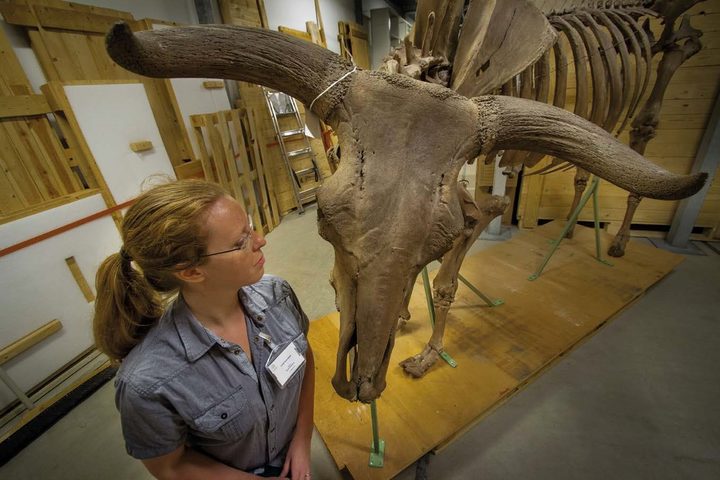Swedish science journalist Torill Kornfeldt has travelled the real world to meet some of the people working on bringing extinct fauna back to life, including dinosaurs and woolly mammoths.

Torill Kornfeldt with an auroch skeleton at Lund University
Listen:
Take notes:
"The first time I heard about the research that you can
bring back extinct species, I sort of felt my inner _________ standing up and
shouting with happiness 'I'm going to see a mammoth'.
She thinks it's __________ that once-extinct species will one
day again walk the earth or fly in the skies.
"I think there will be a lot of _______ whether these
species actually are the species that went extinct or not, but I think
that will be sort of a discussion on ________ and details.
She says bringing back extinct animals is a fairly old idea, and
there were initially other methods of trying to do so.
"There was actually a project in Europe in the '30s of trying
to bring back aurochs by breeding - sort of backbreeding - and trying to
find aurochs' original __________ out of today's cattle and get aurochs'
features out of them.
"But the __________ of de-extinction is only a handful of
years old and it comes from very recent development in genetic technology.
"The ability using a technology that is
called crispr, which gives
scientists the ability to change genetic material in a way that is a lot more
exact and a lot cheaper and more effective that earlier really sort of opens up
a ___________ of possibilities."
Dolly the sheep was cloned in ______, but the process is still
flawed.
"It's miraculous that we can do that and take a cell, any
cell, and start an animal over with the help of that, but it's still a process
that is very difficult, and you still have a very high ___________ among the
embryos that are created in this way.
However, there is a chance it could act as a kind of
conservation _________.
"I think that's the area where de-extinction has the
greatest potential actually, is to be this extra conservation _____
... that you can use when all other hope is lost.
"An example is the northern white rhino, which is a species
where there is only two individuals left today alive, and they are both female
and they cannot _________.
"There are frozen cells preserved of about 11 individuals
of this species, so we could technically ______ them and restart the species
using these frozen cells.
She says scientists' reasons for trying to revive extinct
creatures are largely __________, she says, including extending to solving
environmental problems.
"Most of the species that people are trying to recreate are
species that play a larger role in their __________.
'"The researchers who work with this - I mean, you can
agree or not agree with their aims but all of them are __________. All of them
are people that really try to make the world a better place.
"All of them say that you should prioritise saving what we
have because bringing something back, it will always be a sort of a bad _______,
it will never be the same.
No comments:
Post a Comment